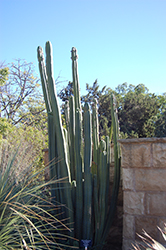It's all about ...
plants

Height: 15 feet
Spread: 5 feet
Sunlight:
![]()
Hardiness Zone: 8b
Other Names: form. Echinopsis pachanoi
Description:
This cactus variety forms towering stands, and over time will create an impressive clump; very slow growing; large, fragrant white flowers are nocturnal; excellent for xeriscaping, and water conservation gardens
Ornamental Features
San Pedro Cactus is a member of the cactus family, which are grown primarily for their characteristic shapes, their interesting features and textures, and their high tolerance for hot, dry growing environments. Like all cacti, it doesn't actually have leaves, but rather modified succulent stems that comprise the bulk of the plant, and which are designed to hold water for long periods of time. This particular cactus is valued for its rigidly upright and cylindrical habit of growth which can occur as either a single spiny ribbed grayish green stem or grow as a cluster of such stems that spread out from a central base. This plant features bold white cup-shaped flowers with chartreuse eyes along the stems from early to late summer.
Landscape Attributes
San Pedro Cactus is a large succulent evergreen plant with a strongly upright, cylindrical form. It tends to form a colony of solitary stems that spread out and away from the base. As a type of cactus, it has no true foliage; the body of the plant is wholly comprised of one or more spiny grayish green stems which are prominently ribbed.
This is a relatively low maintenance plant, and should never be pruned except to remove any dieback, as it tends not to take pruning well. However, secondary stems may be carefully removed at the base to control the spread of the plant. Deer don't particularly care for this plant and will usually leave it alone in favor of tastier treats. It has no significant negative characteristics.
San Pedro Cactus is recommended for the following landscape applications;
- Accent
- Vertical Accent
- Mass Planting
- Hedges/Screening
- General Garden Use
- Container Planting
Planting & Growing
San Pedro Cactus will grow to be about 15 feet tall at maturity, with a spread of 5 feet. It is often either grown as a solitary specimen or permitted to grow into a broader colony as part of a garden composition. It grows at a slow rate, and under ideal conditions can be expected to live to a ripe old age of 100 years or more; think of this as a heritage perennial for future generations!
This plant should only be grown in full sunlight. It prefers dry to average moisture levels with very well-drained soil, and will often die in standing water. It is considered to be drought-tolerant, and thus makes an ideal choice for a low-water garden or xeriscape application. Like most succulents and cacti, this plant prefers to grow in poor soils and should therefore never be fertilized. It is not particular as to soil type or pH. It is somewhat tolerant of urban pollution. This species is not originally from North America. It can be propagated by division.
San Pedro Cactus is a fine choice for the garden, but it is also a good selection for planting in outdoor pots and containers. Because of its height, it is often used as a 'thriller' in the 'spiller-thriller-filler' container combination; plant it near the center of the pot, surrounded by smaller plants and those that spill over the edges. It is even sizeable enough that it can be grown alone in a suitable container. Note that when growing plants in outdoor containers and baskets, they may require more frequent waterings than they would in the yard or garden. Be aware that in our climate, most plants cannot be expected to survive the winter if left in containers outdoors, and this plant is no exception. Contact our experts for more information on how to protect it over the winter months.
This plant is not reliably hardy in our region, and certain restrictions may apply; contact the store for more information.
